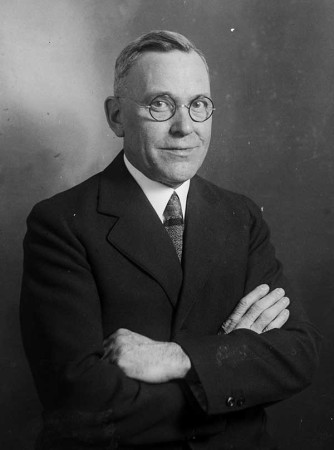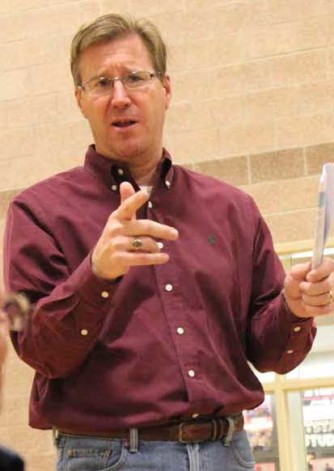“Did you know? Your neighborhood, Stapleton, was named after KKKlansman #1,128 Benjamin Stapleton.”
BlackLivesMatter5280 distributed a flyer with that message to 2,500 homes in Stapleton the night of August 8, 2015. Bianca Pullen, representing the group, says about 25 volunteers participated in this action, and they want to use their influence “to diversify the neighborhood. We believe that there are practices of the neighborhood and culture of the neighborhood that prevent persons of color from living there. We will be engaging in conversations and calling on others in the community to join with us to engage in those conversations with the developers, with the master association…And so we believe that changing the name and the things that will come from this will be a part of creating something that’s more welcoming for people of color.”

Members of the Ku Klux Klan march on Larimer St., Denver on May 31, 1926. Photo from Denver Public Library, Western History Collection.
Stapleton resident Genevieve Swift supports the Black Lives Matter movement and she supports changing Stapleton’s name. Swift joined the Stapleton Community Advisory Board’s Affordable Housing and Diversity Committee a year ago because, she says, “I would like my community to be more diverse.

Genevieve Swift, Stapleton resident and Black Lives Matter supporter
“I’ve reacted to the fact that the name to me represents white supremacy and I think it should be changed. We need a name that represents the ideals of The Green Book (the Stapleton Development Plan) and Stapleton is not that name… There was supposed to be a seamless transition between Stapleton and the rest of northeast Denver. I can tell you, I have a lot of friends who don’t feel comfortable walking the streets of Stapleton. It feels like a gated community to a lot of people and they don’t feel welcome.”
Same issue—14 years earlier
The issue being raised by Black Lives Matter 5280 was brought to the attention of the Stapleton Development Corporation (SDC) by another activist group in 2000. (SDC is an 11-member board of city-appointed volunteers that is charged with preserving the principles of The Green Book. Stapleton land is conveyed by DIA to SDC, whose legal staff places covenants on it requiring that it be developed according to The Green Book.)

Dick Anderson, Stapleton Development Corporation President and CEO from 1998 – 2008.
The SDC took that group’s concerns seriously, according to Dick Anderson, president of SDC from 1998 – 2008, and Terry Whitney, a board member from 1993 to 2002 and from 2011 until now. SDC even invited the activist group to meet in their offices since they didn’t have their own meeting place.
Anderson says the leader of the activist group moved away and that group seemed to dissolve, but both Anderson and Whitney recall multiple meetings at which the board discussed the use of “Stapleton” in association with the new redevelopment project.
Mayor Stapleton and the Klan in Denver
SDC reviewed research on Benjamin Stapleton and the history of the Klan in Denver. SDC records in this time period include an 84-page research document brought in by a board member entitled Home-Grown Racism: Colorado’s Historic Embrace—and Denial—of Equal Opportunity in Higher Education by Richard Delgado and Jean Stefancic (1).
The report states that Klan membership nationwide in1920 was 4,000-5,000 “knights,” but due to their vigorous recruitment efforts, membership nationwide was three to six million by 1924.
“During this period, Colorado was virtually taken over by the Klan. Although Klan domination meant all minorities were threatened, the Klan in Colorado placed Catholics and Jews high on their list of targets, perhaps because the numbers of minorities of color were relatively small.
“Existing social conditions also helped the Klan. In the 1920s, Denver suffered a sharp increase in prostitution, bootlegging, and prohibition violations; police were inefficient and corrupt. The Klan capitalized on these problems, promising to clean up Denver.”
Stapleton was listed in the KKK’s rolls as a member, but he did not make his affiliation public when he ran for mayor. According to Phil Goodstein in his book In the Shadow of the Klan, When the KKK Ruled Denver 1920-1926, when opponents learned he was a Klan member they took out petitions to recall him in 1924. “There was no mention of the Klan in the petition. Nor did it state that Stapleton had to be removed from office because he had lied during the campaign and his first allegiance was to the Invisible Empire, not to the voters and constitutional authority. This was another great success of the Nightriders: their presence was so widespread and malevolent that even their expressed opponents did not wish to make the Klan the central issue of the recall (p.141).”
SDC files also contained a copy of a chapter from Hooded Empire: The Ku Klux Klan in Colorado by Robert Alan Goldberg with information about Mayor Stapleton’s Klan affiliation.

Benjamin Stapleton, elected mayor of Denver in 1923; re-elected to four additional terms; served 20 years as mayor. Photo from Denver Public Library, Western History Collection. Photo by Harry Rhoads
Most SDC board members were longtime Denver residents who had been advocating for years for the creation of a diverse inclusive community on the land vacated by the airport (and a number of that early group are still involved). They understood the historical context of the city and northeast Denver and took into consideration a range of factors as they discussed the use of the word “Stapleton”:
Most people knowledgeable about Denver history understood that politicians in the early 20’s had to be members of the Klan to get elected.
Membership in the Klan wasn’t Stapleton’s only legacy. He served five terms as mayor (20 years) and made numerous contributions to Denver. Stapleton’s accomplishments, according to the Denver Library website include Denver’s water system, the Valley Highway project, a new airport and the Red Rocks Theatre. His daughter-in-law was living in Park Hill in 2000 and was personally known to board members.
The naming resolution
Whitney says Forest City stated very clearly that they needed to use Stapleton as a locator in the marketing of the new development. “There was a certain amount of pressure on the city, and in turn, us, as appointed representatives of different neighborhoods to make sure that this huge infill project was not going to be a bust. So I think that is clearly one of the things that was on our mind.”

Terry Whitney, SDC board member 1993 – 2008 and 2011 to present. Citizens Advisory Board member, 2002 – 2005.
After all the discussion, a resolution about naming was passed. On February 22, 2001, SDC minutes say, “Terry Whitney spoke on the Naming Process for Stapleton and his concern that the naming process should be resolved…After considerable discussion, the Board, by majority decision, adopted the attached resolution.” The resolution said “names…at the developing neighborhood currently known as Stapleton should be created by developers in consultation with the Citizens’ Advisory Board…Developing new names should be done in the most inclusive and sensitive manner recognizing the diversity of communities that will live and work in this evolving Denver neighborhood. This policy is expressly not intended to prohibit references to Stapleton as a location for marketing purposes.”
Whitney says, “…it took a very long time to come up with that very short resolution because of the diversity of viewpoints and having the master developer at the table and them feeling that a change in the name would significantly hamstring their efforts.
“…it was a very long process and ultimately what we tried to do was just the best we could for all those interests combined. I think it was somewhat insightful however that others that had had the ability before us to possibly make a different consideration (change the name of the airport) had not done so. I think that was an important point as well.”
Dick Anderson recalls that there was agreement in the SDC board discussions that the word “Stapleton” would be used in a small font as a “locator” but not as a primary name. He says it was expected that the smaller neighborhood names (Eastbridge, Conservatory Green) would gradually be used more, and the use of Stapleton would diminish.
The newspapers and the Citizens Advisory Board speak out
The subject of the Stapleton name resurfaced in the news a year and eight months later in November 2002 when articles from the Denver Post and Rocky Mountain News talked about SDC’s efforts to reduce the use of the word Stapleton to a “locator.”
A month later, on December 20, 2002, Terry Whitney and Nadine Caldwell, co-chairs of the Stapleton Citizens Advisory Board (CAB) wrote a strongly worded letter to Greg Vilkin at Forest City about their use of “Stapleton” on a holiday card.
The letter started by saying four of the six panels on the card were devoted exclusively to different ways to express “Stapleton.” “Stapleton” was the only information conveyed on those panels.
“We believe the card was inappropriate and insensitive. While it is difficult to accept that Forest city would not understand the reasons for our response, we will summarize those reasons again.
“First it’s about history…Ben Stapleton ran for mayor, sought and secured the support of the Klan in his successful race…Stapleton’s association with the Klan remains deep in the collective memory of Denver’s African-American community.
“In August 1944, over twenty-five years after it had gone into service, the Denver Municipal Airport name was changed to Stapleton Airport, in honor of Ben Stapleton. We did not find any objections in 1944 to this honor. But in 1944 the United States, Colorado and Denver were racially segregated…It is hard to conceive that any 1944 objection to further honoring Ben Stapleton would have been heard, published or taken seriously.
“Second, it’s about our community’s reaction to this history. As the airport moved to DIA, and as the vision of a new use for the land began to develop, the issue of “name” arose. The land abuts the historical African-American neighborhoods in Denver. Stapleton is viewed in many communities as having been a great mayor, and his connection with the original Denver Airport is acknowledged. However, Ben Stapleton’s connection with the building of a new community of homes, schools, parks and businesses, where people of all races, religions and ethnic backgrounds are needed and honored, is something different.
“Several years ago, after much research and broad deliberation, including many discussions with representatives of Forest City, the Stapleton Development Corporation adopted a policy to gradually de-emphasize the use of “Stapleton” in its redevelopment of the former airport…SDC has been criticized by some as not doing enough to eradicate “Stapleton” from the project; we have been criticized by others for trying to rewrite history. We think we are doing the right thing, the right way. However, Forest City continues to disregard the spirit of the Naming Policy.
“Forest City sought continued use of “Stapleton” as a “location for marketing purposes.” The mass distribution of your holiday card went far beyond that use. It sends a message of disinterest of history of the land that you are developing, its residents and the surrounding neighbors. We are disappointed in Forest City.”
Unresolved issues
After all the discussions between 2000 and 2002, SDC was still left with two basic issues they couldn’t solve. The first was that Stapleton wasn’t then (and isn’t now) a name that is officially recorded anywhere. There was nowhere to go to officially “erase” the name and change it to another one. It’s simply a commonly used reference to a location in Denver.
The second issue was that, to the extent people might become accustomed to using another name to denote the location, no one came up with a viable alternative for that purpose.
Perspectives on the “Stapleton” issue today

Stapleton City Councilman Chris Herndon
Those two issues still exist. Stapleton’s Councilman Chris Herndon says he talked to the city attorney who told him, “There’s no legislative action for city council to undertake. There actually isn’t even a process for naming a neighborhood per se, legislatively. We have a process for naming a park or a building. In this instance, the branding, with Forest City being master developer, was their responsibility…how they were going to brand and market and come up with the name for Stapleton.”
Herndon says he has had some emails and one phone call in support of a name change, but no one has suggested an alternative name. He acknowledges that city council and the mayor have the ability to make proclamations, but also raises the question of how a name change might impact the many businesses that have Stapleton in their names.
“As a Stapleton resident and the councilman for the district…I was aware of the history of Benjamin Stapleton, but I also think, when people think of the Stapleton community, they think the name is based off the former airport…But for me, particularly as an African-American living in this community, I don’t think hate or negativity when I think of the name Stapleton.”
Terry Whitney, a longtime Stapleton resident who has served many years on SDC and CAB says of the fliers, “It troubles me that some folks raising concerns about this community’s name seem to be more concerned about a dead racist than ongoing gang violence in northeast Denver. The fact that there are two-thirds of black men nationally that are either incarcerated or under the supervision of the criminal justice system or that even here in Denver last year in 2014 almost 50 percent of Hispanic and Black males didn’t graduate. I just look at the whole thing as misplaced priorities.”

Keven Burnett, Executive Director, Master Community Association
Keven Burnett, executive director of the Master Community Association, Inc. (MCA), points out that the legal names of several of the organizations that make Stapleton work do not contain the word Stapleton. It is not in the legal name of the MCA, though it was added as a DBA (doing business as) to identify where the MCA operates. Stapleton is also not in the name of either Westerly Creek Metro District (the special district that collects tax from Stapleton residents to build Stapleton’s local infrastructure) or Park Creek Metro District (whose main role is to build all Stapleton infrastructure, both regional and local).
Burnett thinks Stapleton is known as a place, not a person. He says the community of Stapleton pays homage to Stapleton as an airport. In keeping with that history, the MCA established an airport theme for the naming of Stapleton pools and oversaw a community process to select those names.
One of the MCA’s goals is to promote an understanding that no matter where anyone lives in Stapleton, they are welcome to use any pool or park in the entire development. They serve all the neighborhoods as a whole. In that sense, the MCA needs an overall name for all the neighborhoods built on the old airport land, even if individual neighborhood names become more commonly used.

Tammi Holloway
Tammi Holloway, currently president of SDC and an attorney for SDC since 1999, has, in a staff role been a part of these discussions for 19 years. She observes, “I think we need to be mindful of the fact that just eradicating the name is not enough to reach some of the goals that Black Lives Matters (BLM) has suggested. I think them raising this issue presents an opportunity for a dialogue on the name, the history and the issues/goals that are important to BLM and where we are as a community with regard to racism and diversity.”
Forest City Vice President Tom Gleason responded with the following email message to a Front Porch request for Forest City’s perspective on the Black Lives Matter flyers. When we requested a follow-up conversation, he responded that he is out of town.

Tom Gleason, Vice President, Forest City
“Forest City and the Stapleton Development Corporation have agreed over the years that the Stapleton name would be used in a limited role as a ‘locator’ (given that it was nationally and internationally known as Denver’s airport for many decades) while we built the inclusive and diverse community envisioned by the citizens of Denver, Aurora and Commerce City who created The Green Book. Over that period of time, we have built eight new neighborhoods on the former airport along with new schools, parks and retail centers—all with new names and without the name of the former airport.”
(1) [1] 70 U. Colo. L. Rev. 703. Copyright 1999, page 9.




It’s not a race issue–other races besides African Americans have been culturally absorbed without much racist bigotry–or have not let that chip sit on their shoulders for 150 years! It’s a cultural issue–the African American culture rejects education and honest work as a ladder to success. Who’s building Stapleton and working 6 days/wk, 12 hours/day? You won’t see the hispanic community on the welfare rolls or in our prison system in the next generation. I agree with Terry Whitney–time should be spent trying to change the black culture rather than change a name most people don’t even know belonged to a politician who had to join the KKK to get elected (and the KKK in Denver didn’t even focus on blacks because there weren’t many at that time!) It was an interesting article but so frustrating to see people focusing on really silly stuff when there’s a LOT of bigger fish to fry!
Unfortunately changing the name will not solve the problem that the Stapleton area, Denver, Colorado, or the USA faces today regarding race. It’s not about a name; it’s about how we as a nation treat those who are not the majority. That’s the discussion that needs to be had and truly addressed.